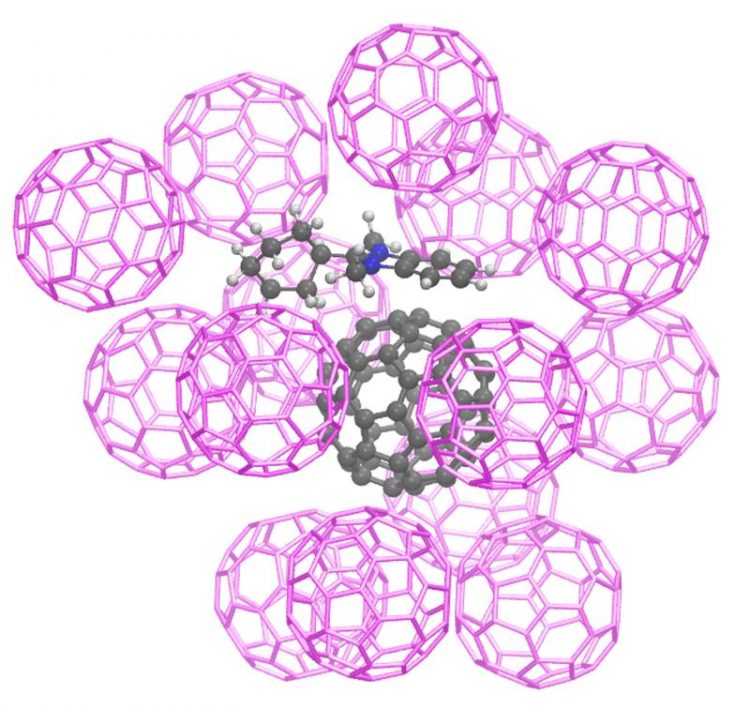Cfaed researchers of TU Dresden uncover doping in organic semiconductors

Geometry of a molecular cluster of dopant and host molecules with benzimidazoline dopant and a C60 molecule S. Schellhammer/ F. Ortmann
In semiconductor technology, doping refers to the intentional introduction of impurities (also known as dopants) into a layer or into the intrinsic semiconductor of an integrated circuit. These dopants are deliberate modifications of the semiconductor, with which the behavior of the electrons and thus the electrical conductivity of the intrinsic material can be controlled.
Even the smallest amounts of dopants can have a strong impact on the electrical conductivity. Electronic modifications by doping make semiconductors functional in all major electronic devices – the backbone of the electronics industry.
Although the principle of doping of conventional semiconductors was described in 1950 by the US physicist John Robert Woodyard, there is still discussion about this processes in organic semiconductors. This is because both the dopants and the semiconductor material consist of molecules and the doping efficiency is affected by various effects that are not yet well understood.
A group of physicists from the TU Dresden around the cfaed independent research group leader Dr. Frank Ortmann (Computational Nanoelectronics Group) was able to show how different doping properties can be simulated and subsequently experimentally verified.
For this purpose, the density of states and the Fermi level position of the prototypic materials C60 and zinc phthalocyanine (ZnPc), which were n-doped with highly efficient benzimidazoline radicals (2-Cyc-DMBI), were simulated and experimentally determined by direct and inverse photoemission spectroscopy.
This collaboration work with researchers from Japan and cfaed investigators Prof. Karl Leo (Chair of Opto-Electronics) und Prof. Gianaurelio Cuniberti (Chair of Material Science and Nanotechnology) from TU Dresden has now been published in the renowned journal “Nature Materials”.
The scientists investigate the role of electronic band gap states that are created on doping. In particular, they identified the energetic difference Δ between the electron affinity of the undoped molecule and the ionization potential of its doped counterpart (in the vicinity of dopants) as a key parameter for efficient doping.
“This parameter is critical for the generation of free charge carriers and thus influences the conductivity of the doped films,” said Ortmann. “Strategies for optimizing the electronic properties of organic semiconductors can be studied and characterized by changes in the value of Δ.”
Paper title: “Insight into doping efficiency of organic semiconductors from the analysis of the density of states in n-doped C60 and ZnPc” (Nature Materials)
DOI: 10.1038/s41563-018-0030-8
Authors: Christopher Gaul, Sebastian Hutsch, Martin Schwarze, Karl Sebastian Schellhammer, Fabio Bussolotti, Satoshi Kera, Gianaurelio Cuniberti, Karl Leo, Frank Ortmann
About the Computational Nanoelectronics Group:
The research group at the Center for Advancing Electronics Dresden (cfaed) headed by Dr. Frank Ortmann investigates electronic properties and charge transport properties of novel semiconductor materials. Here, organic semiconductors are currently an important focus of the work, which is funded by the German Research Foundation under the Emmy Noether Program. The group has been based at the cfaed since 2017.
Info: https://cfaed.tu-dresden.de/ortmann-home
Press Contact:
Dr. Frank Ortmann
Technische Universität Dresden
Center for Advancing Electronics Dresden
Tel.: +49 (0) 351 463-43260
E-Mail: frank.ortmann@tu-dresden.de
Matthias Hahndorf
cfaed, Head of Communications
Tel.: +49 (0) 351 463-42847
E-Mail: matthias.hahndorf@tu-dresden.de
cfaed
cfaed is a microelectronics research cluster funded by the German Excellence Initiative. It comprises 11 cooperating institutes in Saxony, host university is the Technische Universität Dresden (TUD). About 300 scientists from more than 20 countries investigate new technologies for electronic information processing. These technologies are inspired by innovative materials such as silicon nanowires, carbon nanotubes or polymers or based on completely new concepts such as the chemical chip or circuit fabrication methods by self-assembling structures such as DNA-Origami. The orchestration of these new devices into heterogeneous information processing systems with focus on their resilience and energy-efficiency is also part of cfaed’s research program which comprises nine different research paths.
Media Contact
All latest news from the category: Physics and Astronomy
This area deals with the fundamental laws and building blocks of nature and how they interact, the properties and the behavior of matter, and research into space and time and their structures.
innovations-report provides in-depth reports and articles on subjects such as astrophysics, laser technologies, nuclear, quantum, particle and solid-state physics, nanotechnologies, planetary research and findings (Mars, Venus) and developments related to the Hubble Telescope.
Newest articles

First-of-its-kind study uses remote sensing to monitor plastic debris in rivers and lakes
Remote sensing creates a cost-effective solution to monitoring plastic pollution. A first-of-its-kind study from researchers at the University of Minnesota Twin Cities shows how remote sensing can help monitor and…

Laser-based artificial neuron mimics nerve cell functions at lightning speed
With a processing speed a billion times faster than nature, chip-based laser neuron could help advance AI tasks such as pattern recognition and sequence prediction. Researchers have developed a laser-based…

Optimising the processing of plastic waste
Just one look in the yellow bin reveals a colourful jumble of different types of plastic. However, the purer and more uniform plastic waste is, the easier it is to…


